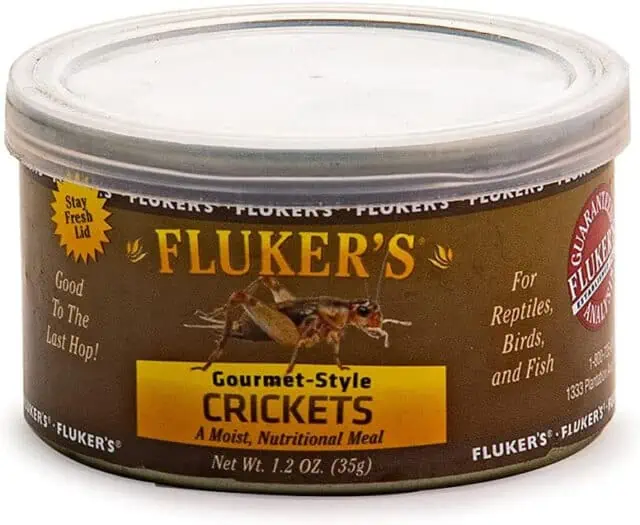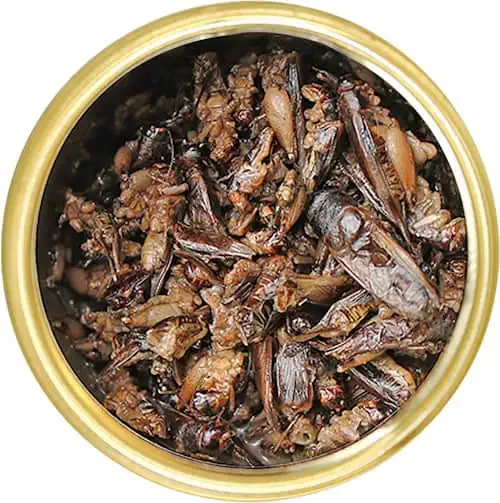Yes, leopard geckos can eat canned crickets. However, while they offer convenience, it’s essential to understand their nutritional content and how they compare to live crickets.
Nutritional Balance: Canned crickets provide around 20% protein but may lack other essential nutrients; ensure to supplement with calcium and vitamin dusting.
Safe Storage: Keep canned crickets in the refrigerator for up to one week, discarding any that develop an off odor or visible mold to ensure freshness.
Dietary Diversity: Introduce a variety of insects like dubia roaches, mealworms, and grasshoppers to provide a well-rounded diet and ensure all nutritional needs are met.
Handling Precautions: Always handle canned crickets with clean hands or utensils and wear gloves to avoid direct contact with potential preservatives or additives.
Feeding Frequency: Adult leopard geckos typically require feeding every other day, while younger ones may need daily meals, adjusting portions according to age and size.
Can Leopard Geckos Eat Canned Crickets?
Certainly, leopard geckos can consume canned crickets. These pre-packaged insects provide a quick and hassle-free feeding option for gecko owners. However, it’s crucial to weigh the pros and cons of this choice.
Nutritional Content of Canned Crickets

Canned crickets are a popular choice among reptile enthusiasts due to their convenience. When it comes to their nutritional content, these crickets are packed with protein, essential for the growth and muscle development of leopard geckos. On average, canned crickets contain about 20% protein, along with other vital nutrients such as calcium, fiber, and fats.
| Nutrient | Percentage |
|---|---|
| Protein | 20% |
| Calcium | 0.9% |
| Fiber | 3% |
| Fats | 5% |
However, there are some drawbacks to consider. Canned crickets often lack the freshness that live crickets offer. This lack of freshness can sometimes translate to a slightly lower nutritional value. Live crickets, being more active, can stimulate a leopard gecko’s hunting instincts, providing both nutrition and enrichment.
Leopard geckos require a range of essential nutrients for optimal health. These include protein, calcium, and certain vitamins. While canned crickets can contribute significantly to their protein intake, they might not always provide the full spectrum of essential nutrients in the right proportions.
It’s crucial to supplement their diet with other food sources or vitamins to ensure they receive all the essential nutrients they need.
Pros and Cons of Canned Crickets
Feeding canned crickets to leopard geckos comes with its set of advantages and disadvantages. Let’s delve into the pros and cons to provide a clearer picture.
Pros:
- Convenience: Canned crickets are readily available and can be stored for extended periods, making them a handy option for gecko owners.
- Safety: With canned crickets, there’s a reduced risk of introducing parasites or diseases that might be present in live crickets.
- Nutritional Benefits: Canned crickets still offer a decent amount of protein and other nutrients, making them a viable food source.
Cons:
- Lack of Freshness: Unlike live crickets, canned ones lack freshness, which can affect their overall nutritional value.
- Less Stimulation: Live crickets can stimulate a leopard gecko’s hunting instincts, providing both a meal and a form of entertainment.
- Potential Additives: Some canned crickets might contain preservatives or other additives, which aren’t ideal for a gecko’s diet.
The nutritional benefits of canned crickets are evident in their protein content and the absence of potential parasites. However, the drawbacks, such as the potential lack of certain nutrients and the presence of additives, make it essential to be cautious.
There are potential risks and health concerns associated with feeding canned crickets. The presence of preservatives or additives can lead to digestive issues or other health problems in leopard geckos. It’s crucial to source high-quality canned crickets and ensure they are free from harmful substances.
For a well-rounded diet, it’s recommended to introduce alternative food sources for leopard geckos. Some excellent alternatives include dubia roaches, mealworms, and other insects. These can supplement the diet, ensuring the gecko receives a diverse range of nutrients and enjoys a varied diet.
Other Food Sources for Leopard Geckos
Leopard geckos are insectivorous reptiles with a natural inclination towards a diet rich in insects. While canned crickets are a convenient option, it’s essential to introduce a variety of food sources to ensure a balanced and nutritious diet. Here’s a closer look at some of the suitable food sources for leopard geckos:
Dubia Roaches: These are a favorite among many gecko owners due to their high protein content and the ease of breeding them. They’re also less likely to carry parasites, making them a safe option.
Crickets: Live crickets are a staple in a leopard gecko’s diet. They’re readily available and provide good nutrition, especially when gut-loaded before feeding.
Mealworms: These worms, including canned mealworms, are another popular choice. They’re rich in protein and fats, making them an energy-packed snack for geckos. Canned mealworms are also available, as an alternative to crickets.
Caterpillars: Certain types of caterpillars can be a nutritious treat for leopard geckos. However, it’s essential to ensure they’re safe for consumption and free from pesticides.
Grasshoppers: These insects are another natural prey for leopard geckos in the wild. They offer a good mix of protein and other essential nutrients.
The world of insects is rich, and there are many different ones that the leo would hunt in the wild. From water bugs to stink bugs, and many other insects, the options are there. I would still suggest you stick with variants that you know don’t cary any diseases.
Preparing and Serving Canned Crickets to Leopard Geckos:
Feeding your leopard gecko involves more than just offering food; it’s about ensuring the food is safe, nutritious, and presented in a way that’s appealing to them. When it comes to canned crickets, there are specific steps and precautions to consider.
Proper Storage of Canned Crickets
Ensuring the freshness and safety of canned crickets is paramount for the health of your leopard gecko. Proper storage plays a crucial role in maintaining the quality of these pre-packaged insects. Once opened, it’s advisable to transfer the crickets to an airtight container and store them in the refrigerator. This cool environment helps retain their freshness, allowing them to be used for up to one week.
However, like any other food product, canned crickets have a shelf life. If you notice a foul smell emanating from the container or spot visible mold, it’s a clear sign that the crickets have gone bad and should be discarded immediately. Serving spoiled crickets can lead to health issues for your gecko, so it’s always better to err on the side of caution.
Another aspect to consider is the potential presence of preservatives and other additives in canned crickets. While these substances help extend the product’s shelf life, they might not be ideal for your gecko’s health. Always check the label for any added chemicals and, if possible, opt for brands that offer natural and preservative-free options.
How to Serve Canned Crickets to Leopard Geckos
Serving canned crickets to your leopard gecko requires a methodical approach to ensure their health and safety. Here’s a step-by-step process to guide you through this feeding routine:
1. Portioning: Begin by determining the right portion size for your gecko. For an average-sized adult leopard gecko, a serving of 5-7 canned crickets is usually sufficient. However, this can vary based on the gecko’s age, size, and activity level.
2. Inspection: Before serving, inspect the canned crickets for any signs of spoilage, such as an off-putting smell or mold. Discard any that seem questionable.
3. Preparation: If the canned crickets are refrigerated, allow them to come to room temperature. This makes them more palatable for the gecko. You can also dust the crickets with a calcium or vitamin supplement to enhance their nutritional value.
4. Serving: Place the crickets in a shallow dish inside the gecko’s enclosure. This allows the gecko to easily access and consume them.
5. Monitoring: Watch your gecko as it eats. This not only ensures they’re eating the crickets but also allows you to observe for any signs of discomfort or refusal, which could indicate an issue with the food.
6. Cleanup: After feeding, remove any uneaten crickets from the enclosure to maintain cleanliness and prevent any potential decay.
When it comes to the frequency of feeding, adult leopard geckos typically eat every other day, while younger geckos might require daily feeding. However, it’s essential to adjust based on your gecko’s specific needs and appetite.
Safety Precautions When Handling Canned Crickets
When dealing with canned crickets, it’s essential to be aware of the safety precautions to ensure the well-being of both the handler and the leopard gecko. One of the primary concerns associated with canned crickets is the potential presence of preservatives and additives.
These substances, while extending the shelf life of the product, might pose risks if consumed in large quantities or if they come into contact with sensitive areas.
Proper handling techniques are crucial to mitigate these risks. Emphasizing cleanliness and hygiene is paramount. Before handling the crickets, it’s advisable to wash your hands thoroughly with soap and water.
This step helps in removing any contaminants that might be present on your hands, preventing them from transferring to the crickets and, subsequently, to your gecko. When placing the crickets into the feeding dish, using sanitized tools or utensils can further reduce the risk of contamination.
Additionally, certain key safety measures can enhance the handling process. Wearing gloves, for instance, provides an added layer of protection, preventing direct contact with any potential additives in the crickets.
It’s also essential to avoid touching your face, especially the eyes and mouth, during the handling process.





